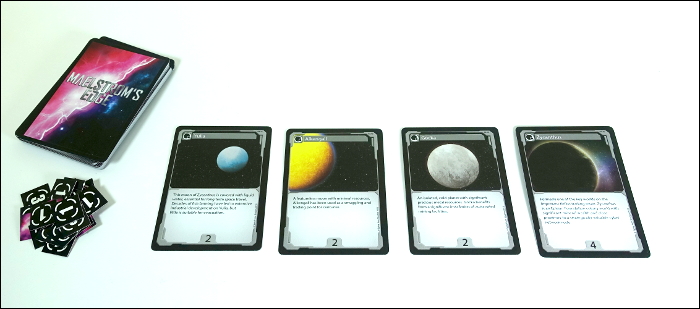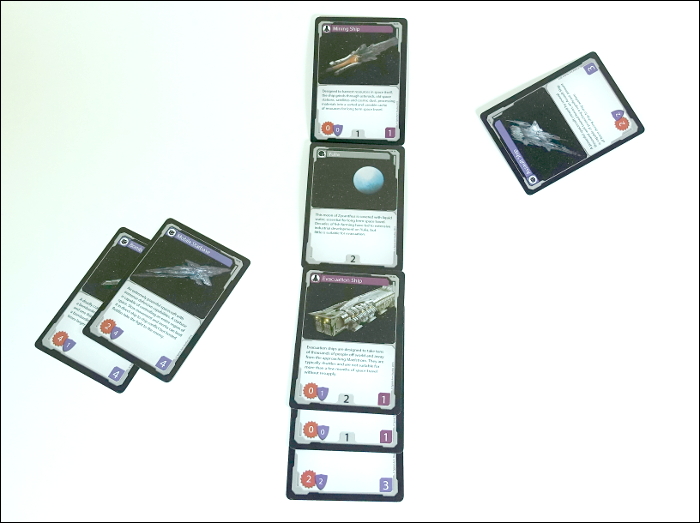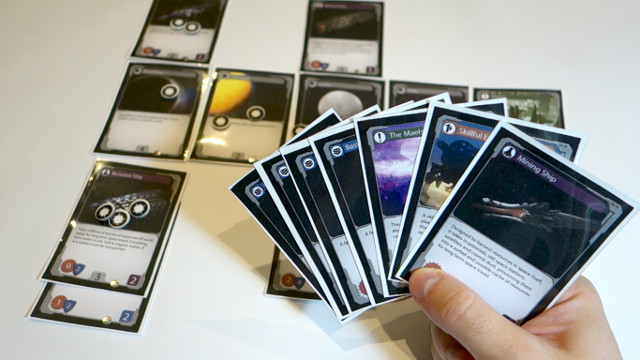The Maelstrom's Edge Card Game
Every copy of Battle for Zycanthus includes the Maelstrom's Edge Card Game - a fast-paced, strategic card game in which your faction tries to secure as many resources as possible from a selection of planets and moons that are doomed by the Maelstrom. The game is designed for two players and takes around 15-25 minutes to play - perfect if you are waiting for a tabletop gaming table to free up.
This is a living ruleset, this version is dated 28 Dec 2015 and replaces all previous versions.
Playing Area

The playing area consists of four planet cards with a space above and below each for players to attach cards. A common draw deck represents the stream of refugees, events and situations arising as the Maelstrom draws closer to the four planets.
Anatomy of a Card
Card Types
| Faction - Black Backgrounds | |
| Each player takes one faction card to begin the game. |
| Planet (including moons and space stations) - Grey Backgrounds | |
| Each game should be played with four planet cards. |
| Syphon - Purple Backgrounds | |
| Each player has three syphon ships - a Mining Ship, an Evacuation Ship and a Resource Ship. |
| Military - Light Blue Backgrounds | |
| Each player starts with two random military ships. Military ships are the most common cards in the deck. |
| Event - Green Backgrounds | |
| Events are present in the draw deck and can dramatically alter the flow of the game. |
| Modifier - Orange Backgrounds | |
| Modifier cards allow the buffing or nerfing of cards in play |
Game Concept
Each player takes turns performing actions enabled by the cards in their hand. The ultimate goal is to accrue as many resources as possible, with resources being generated each turn by the planets themselves. Resources represent anything useful to the spacebound fleets escaping the Maelstrom's Edge and could include raw materials, finished goods, water, fuel and people!
The winner is the player who ends the game with the most resources, and a big part of the strategy of the game revolves around handicapping your opponent while maximising your resources.
Game Setup
- Place the four planet cards in the center of your playing area side by side (with some space between each card to give room for any planetary modifier cards).
- Each player takes one faction card showing which faction they are fighting for.
- Each player gets three syphons - a Mining Ship, an Evacuation Ship and a Resource Ship.
- Take all military cards out of the deck, shuffle those military cards, then deal 2 random ones to each player.
- Deal 5 resources to each player. Resources are best counted using tokens, counters, coins or anything you have to hand. We recommend you use command point tokens from the Maelstrom's Edge boxed set if you do not have anything appropriate, but find it is a lot more satisfying playing with more physical tokens such as glass gems.
At this point, a player should have a faction card (on the table), 5 cards in hand (3 syphons and 2 military cards), 5 resources in their stockpile, and there should be 4 planets in total in the play area. Shuffle all remaining cards into a single deck (the 'draw deck') and place it within reach of both players.
Each player will also need a way of noting numbers from 0-10 secretly. This could be done with a pen and paper, but we've generally found it easiest to just use a calculator app on our phones.
The players should then toss a coin to choose who goes first. The winner of the coin toss can decide if they want to play first or second. The reacting player (the player who goes second) usually has a small advantage as they can respond to threats more easily.
Turn Structure
1. Resource Generation
Each planet generates a number of resources equal to the large grey number in the lower middle of the card, modified by any modifier cards attached to the planet. At the start of the game, each planet generates two resources except Zycanthus which generates four resources. The generated resources must be placed on the cards themselves.
Each faction card also generates one resource at this time and we recommend putting the resource onto the faction card so that you donít get in the habit of forgetting to do so as the action increases! This resource represents reinforcements for the faction arriving in system, as well as more resources being committed internally by the faction.
2. Resource Distribution
Resources are distributed to players based on the number of syphons they have attached to a planet (this will always be '0' in the first turn, so you can skip this step on turn 1). Resource distribution is the most complicated part of the Maelstrom's Edge Card Game and is done as follows for each planet:
- Add up the 'syphon rate' by combining the syphon value of all syphon cards attached by a player to a planet. Do this for both players (eg; player 1 might have a syphon rate of '2' thanks to their evacuation ship, and player 2 might a syphon rate of '4' thanks to their resource ship and mining ship being attached.
- Each player then takes resources off the planet card equal to their syphon rate. A couple of special circumstances apply though:
- If there are not enough resources on the planet card for both players to syphon, but the total syphon rate of each player's cards on that planet is less than or equal to the resource generation rate of that planet, each player can take additional resources up to the syphon rate of the planet.
For example: player 1 has a syphon rate of '2' and player 2 has a syphon rate of '4'. Both are attached to Zycanthus which has a resource generation rate of 4, but Zycanthus has only 5 resources on the card. Player 1 takes their two syphoned resources from the Zycanthus card, and player 2 takes the remaining three resources, as well as one additional resource because they can syphon 4 resources in total, and Zycanthus has a resource generation rate of 4.
Second example: player 1 has a syphon rate of '3' and player 2 has a syphon rate of '3'. Both are attached to Gocka which has a resource generation rate of 2, and Gocka has only 2 resources on the card. Each player takes one resource from the stockpile, and then one additional resource. Even though they can syphon 3 resources in total, Gocka has a resource generation rate of 2, so each player can only take two resources in total. Having so many syphons attached to the card, at the planet's maximum resource generation rate gives the planet an effective resource generation of '4' per turn as a result, representing the population's desire to get off-world as quickly as possible given the rare opportunity of assistance from space.
- If both players have an equal syphon rate, but there are not enough resources on the planet to cover this, each player takes the same number of resources. If there is an odd number, the leftover resource is left on the card.
For example: Player 1 has a syphon rate of '4' and player 2 has a syphon rate of '4'. Both are attached to Gocka which has a syphon rate of 2, and Gocka has 5 resources stockpiled on it. Each player receives 2 resources, leaving the remaining one on Gocka. Because Gocka's resource generation rate is only '2', no additional resources can be drawn. Unless any modifiers are applied to Gocka to increase the rate of resource generation, each player will only see two resources per turn from Gocka.
- If there are not enough resources on the planet card for both players to syphon, but the total syphon rate of each player's cards on that planet is less than or equal to the resource generation rate of that planet, each player can take additional resources up to the syphon rate of the planet.
In addition to planetary resources, each player takes the generated resource off their faction card and puts it into their stockpile.
3. Actions
The player with the most resources goes first to represent their inertia. In the event of a tie, where both players have the same number of resources, toss a coin and the winning player can choose if they would like to go first or second during this action phase.
Each player MUST perform two actions in their turn. An action can be:
- Playing a card from their hand
- Attacking with their 'attack' military cards.
Playing a Card
Playing a card from your hand is relatively straightforward. Simply pay the cost in resources indicated in the bottom right of the card - usually from 0 to 5 resources. Each type of card is played in a different fashion.
Syphon Cards
A Syphon card can be attached to any planet. You can attach as many syphon cards to a planet as you wish, though putting all your eggs in one basket makes them easier to defend, it does carry some significant risks!
Military Cards
Military cards can either be attached to an in-play syphon card, adding their defensive value to the syphon and making it harder to destroy, or can be put into an 'attack' area. Attack area cards can then be used to attack your opponent and the details of that will be covered below in the 'battles' section. Stacks of cards attached to syphons have no limit to their stack size, but stacks in the attack area are limited to two military cards per stack (modifiers can be added on top of them though). You can have as many attack stacks as desired, but attacking with one counts as an action. You can attack twice with the same attack stack in one turn but doing so will count as two actions.

Event Cards
Event cards are unique in that they can be played at any time, even during the other player's turn (unless otherwise specified on the card). Event cards contain instructions and/or specific rules for that card which must be followed. Event cards also include two copies of 'The Maelstrom' event - each are a unique event which will be a fear in the back of your mind throughout the game. Playing an event on your turn counts as an action, but playing it on your opponent's turn does not count as one of their actions.
'The Maelstrom' event cards can be played at any time, and if played during your opponent's turn, immediately negates the previous action taken. If the previous action is a military attack, the action is only negated if you play the maelstrom before the attack is resolved (so you must play the maelstrom card before the attack/defense values are added together). Otherwise, the previous action such as placement of an event, modifier, syphon, etc does not happen and the card remains in your opponent's hand. You are free to play 'The Maelstrom' in your turn as well but it does not negate your previous action.
The Maelstrom completely destroys a random planet along with all cards (including syphons, military, events, modifiers) attached to it. To decide which planet is 'random' becomes a game of bluffing between you and your opponent. Each player must secretly choose a number between 0 and 10, then reveal those numbers to each other at the same time. Those numbers are added up. If the total is '0', The Maelstrom has no effect and is discarded. If the number is 1-20, start counting from the left most planet (1), then each time you reach the right most planet, jump back to the left most planet. For example, if there are 4 planets in play and the players choose '6' as their combined number, the second planet from the left (and attached cards) would be destroyed (4, 2). If there are 3 planets in play and the players choose '9' as their combined number, the rightmost planet and cards would be destroyed (3, 3, 3).
Modifier Cards
Modifier cards allow the buffing or nerfing of cards in play and are attached to cards in the playing area. There is no limit to how many modifiers can be applied, but any modifiers must be added in the order they went down. Modifiers typically have instructions on the card to follow. When a card with modifier or event cards attached to it is destroyed, those modifier and/or event cards are also destroyed.
For example, Gocka with a resource generation rate of 2, has 'skillful evacuees' applied (+2 resource generation rate), which would give it a resource generation rate of 4, but it already had the 'Double Output' event applied to it (double resource rate), giving it a resource rate of (2 x 2) + 2 = 6, as opposed to (2 + 2) X 2 = 8 had 'Skillful Evacuees' been applied before 'Double Output'.
Moving Cards
During the action phase, the active player may pay 1 resource to move a card from any location to any other location. They may do this as much as they want, paying 1 resource for each card they move.
4. Draw Up
After both players have performed two actions, each player draws cards from the draw deck until they have 7 cards in their hand. On turn one, this typically results in 4-5 new cards being drawn. This is done after both players have performed their actions so that the starting player does not get additional turns through extra drawn event cards.
After that, back to resource generation for another turn!
Victory Conditions
The game ends when the draw deck is empty, and when either player has 3 or fewer cards left in their hand. As such, neither player can be absolutely certain when the game will end but are aware that the end is near. The winning player is the one with the most resources in their stockpile at the end of the game.
Battles
Attacking and defending is a major part of the Maelstrom's Edge Card Game. The flow of a battle is as follows:
- The attacker chooses one of their attack stacks, and states where they are attacking. They can attack any one of:
- An enemy attack card stack
- An enemy syphon stack attached to a planet
- A planet
- Each card capable of fighting has an attack value and a defense value in the bottom left. The combined value of these along with any attached modifiers or events gives the total attack or defense values of that stack.
- The raw attack/defense values on the cards are not the only thing used in the battle - each faction is desperate to win whenever they can, so most of the time they will be willing to commit resources to the fight as well. Each player must secretly bid as many resources from their stockpile as they are willing to spend to win the battle. This can be 0 if they are confident of victory or loss, or are feinting an attack in an attempt to make their opponent waste resources. Both player's secret resource bids are revealed to each other at the same time.
- The combined value of the attacker's attack stack + attacking players bid is put against the combined value of the defender's defence stack + defending player's bid. The results of the battle can be one of the following:
- The attacker has a higher combined value than the defender, the attacker chooses one of the defender's cards to destroy from the battle.
- The values are equal, nothing happens.
- The defender has a higher combined value than the attacker, the defender chooses one of the attacker's cards to destroy from the battle.
Note that for military cards attached to one or more syphons, attached to a planet, the military cards must all be destroyed before the syphons can be destroyed, and the syphons must all be destroyed before the planet can be attacked.
A planet has no defense value and cannot be destroyed. Instead, when attacking an undefended planet (where there are no military or syphon cards attached), the planet loses a number of resources from its stockpile equal to the combined attack value of the attacker's stack. The planet cannot lose more resources than it has in the stockpile.
Destroyed and Discarded Cards
Cards which are destroyed or discarded go into a discard pile, and are then out of use for the rest of the game.
Conclusion
That covers the rules for the Maelstrom's Edge Card Game. The best way to get to know them is to play a game or two, so dive right in! If you have any questions please post them in the Maelstrom's Edge community forum on DakkaDakka.com and we'll answer them there and will merge in any changes or FAQs to this page!
Thanks for reading and we hope you enjoy the game!





